Dynamic Absorptive Capability and Innovation Performance: Evidence from Chinese Cities
Abstract
:1. Introduction
2. Literature Review
2.1. The Concept of ACAP
2.2. Multi-Dimensional ACAP
2.3. ACAP and Innovation Performance
3. Materials and Methods
3.1. Research Design
3.2. Measure of Regional ACAP
3.3. Control Variables
4. Results
4.1. Explanatory Variables
4.2. The Spatial Distribution of Multidimensional ACAP
4.3. Regression Results
5. Conclusions and Discussion
Author Contributions
Funding
Conflicts of Interest
References
- Cohen, W.M.; Levinthal, D.A. Absorptive Capacity: A New Perspective on Learning and Innovation. Adm. Sci. Q. 1990, 35, 128–152. [Google Scholar] [CrossRef]
- Tang, Y.; Chen, Y.; Wang, K.; Xu, H.; Yi, X. An Analysis on the Spatial Effect of Absorptive Capacity on Regional Innovation Ability Based on Empirical Research in China. Sustainability 2020, 12, 3021. [Google Scholar] [CrossRef] [Green Version]
- Kallio, A.; Harmaakorpi, V.; Pihkala, T. Absorptive Capacity and Social Capital in Regional Innovation Systems: The Case of the Lahti Region in Finland. Urban Stud. 2010, 47, 303–319. [Google Scholar] [CrossRef]
- Soo, K.T. Innovation across cities. J. Reg. Sci. 2018, 58, 295–314. [Google Scholar] [CrossRef] [Green Version]
- Zeng, J.; Liu, Y.; Wang, R.; Zhan, P. Absorptive Capacity and Regional Innovation in China: An Analysis of Patent Applications, 2000–2015. Appl. Spat. Anal. Policy 2019, 12, 1031–1049. [Google Scholar] [CrossRef]
- Nooteboom, B.; Van Haverbeke, W.; Duysters, G.; Gilsing, V.; van den Oord, A. Optimal cognitive distance and absorptive capacity. Res. Policy 2007, 36, 1016–1034. [Google Scholar] [CrossRef] [Green Version]
- Thomas, R.; Wood, E. Innovation in tourism: Re-conceptualising and measuring the absorptive capacity of the hotel sector. Tour. Manag. 2014, 45, 39–48. [Google Scholar] [CrossRef]
- Giuliani, E. Cluster Absorptive Capacity: Why do Some Clusters Forge Ahead and Others Lag Behind? Eur. Urban Reg. Stud. 2005, 12, 269–288. [Google Scholar] [CrossRef]
- Kim, L. Crisis Construction and Organizational Learning: Capability Building in Catching-up at Hyundai Motor. Organ. Sci. 1998, 9, 506–521. [Google Scholar] [CrossRef] [Green Version]
- Abreu, M. Absorptive capacity in a regional context. In Handbook of Regional Innovation and Growth; Cooke, P., Asheim, B., Boschma, R., Martin, R., Schwartz, D., Todtling, F., Eds.; Edward Elgar: Cheltenham, UK, 2011; pp. 211–221. [Google Scholar]
- Agrawal, A.; Cockburn, I.; Rosell, C. Not Invented Here? Innovation in company towns. J. Urban Econ. 2010, 67, 78–89. [Google Scholar] [CrossRef] [Green Version]
- Freund, D.; Lee, R.; Tüselmann, H.; Cao, Q. International high-tech SMEs innovative foreign knowledge inflows: Effects of host country weak network ties and absorptive capacity. Multinatl. Bus. Rev. 2020, 28, 333–354. [Google Scholar] [CrossRef]
- Mowery, D.C.; Oxley, J.E. Inward technology transfer and competitiveness: The role of national innovation systems. Camb. J. Econ. 1995, 19, 67–93. [Google Scholar] [CrossRef]
- Roper, S.; Love, J.H. Innovation and regional absorptive capacity: The labour market dimension. Ann. Reg. Sci. 2006, 40, 437–447. [Google Scholar] [CrossRef] [Green Version]
- Giuliani, E.; Arza, V. What drives the formation of ‘valuable’ university–industry linkages?: Insights from the wine industry. Res. Policy 2009, 38, 906–921. [Google Scholar] [CrossRef]
- Gertler, M.S. Rules of the Game: The Place of Institutions in Regional Economic Change. Reg. Stud. 2010, 44, 1–15. [Google Scholar] [CrossRef]
- Sun, Y.; Cao, C. The evolving relations between government agencies of innovation policymaking in emerging economies: A policy network approach and its application to the Chinese case. Res. Policy 2018, 47, 592–605. [Google Scholar] [CrossRef]
- Schillaci, C.E.; Romano, M.; Nicotra, M. Territory’s Absorptive Capacity. Entrep. Res. J. 2013, 3, 109–126. [Google Scholar] [CrossRef] [Green Version]
- Etzkowitz, H. The Triple Helix: University-Industry-Government Innovation in Action; Routledge: London, UK, 2008; pp. 20–40. [Google Scholar]
- Hemert, P.V.; Iske, P.L. Framing knowledge-based urban development and absorptive capacity of urban regions: A case-study of Limburg, the Netherlands. Int. J. Knowl. Based Dev. 2015, 6, 314. [Google Scholar] [CrossRef]
- Leydesdorff, L.; Fritsch, M. Measuring the knowledge base of regional innovation systems in Germany in terms of a Triple Helix dynamics. Res. Policy 2006, 35, 1538–1553. [Google Scholar] [CrossRef] [Green Version]
- Castells, M. The Rise of the Network Society; Blackwell Publishers: Malden, MA, USA, 2000; pp. 407–460. [Google Scholar]
- Meijers, E. From Central Place to Network Model: Theory and Evidence of a Paradigm Change. Tijdschr. Econ. Soc. Ge. 2007, 98, 245–259. [Google Scholar] [CrossRef]
- Simmie, J.; Martin, R. The economic resilience of regions: Towards an evolutionary approach. Camb. J. Reg. Econ. Soc. 2010, 3, 27–43. [Google Scholar] [CrossRef] [Green Version]
- Boschma, R. Towards an Evolutionary Perspective on Regional Resilience. Reg. Stud. 2015, 49, 733–751. [Google Scholar] [CrossRef] [Green Version]
- Huggins, R.; Izushi, H.; Prokop, D. Regional advantage and the geography of networks: Explaining global-local knowledge sourcing patterns. Pap. Reg. Sci. 2019, 98, 1567–1584. [Google Scholar] [CrossRef]
- Boschma, R.A.; ter Wal, A.L.J. Knowledge Networks and Innovative Performance in an Industrial District: The Case of a Footwear District in the South of Italy. Ind. Innov. 2007, 14, 177–199. [Google Scholar] [CrossRef] [Green Version]
- Schmidt, T. Absorptive capacity-one size fits all? A firm-level analysis of absorptive capacity for different kinds of knowledge. Manag. Decis. Econ. 2010, 31, 1–18. [Google Scholar] [CrossRef] [Green Version]
- Martin, R.; Sunley, P. Path dependence and regional economic evolution. J. Econ. Geogr. 2006, 6, 395–437. [Google Scholar] [CrossRef]
- Teece, D.J.; Pisano, G.; Shuen, A. Dynamic capabilities and strategic management. Strateg. Manag. J. 1997, 18, 509–533. [Google Scholar] [CrossRef]
- Zahra, S.A.; George, G. Absorptive Capacity: A Review, Reconceptualization, and Extension. Acad. Manag. Rev. 2002, 27, 185–203. [Google Scholar] [CrossRef]
- Parada, M.J. Comment on “Territory’s Absorptive Capacity”. Entrep. Res. J. 2013, 3, 141–146. [Google Scholar] [CrossRef] [Green Version]
- Lane, P.J.; Koka, B.R.; Pathak, S. The reification of absorptive capacity: A critical review and rejuvenation of the construct. Acad. Manag. Rev. 2006, 31, 833–863. [Google Scholar] [CrossRef]
- Vasudeva, G.; Anand, J. Unpacking Absorptive Capacity: A Study of Knowledge Utilization from Alliance Portfolios. Acad. Manag. J. 2011, 54, 611–623. [Google Scholar] [CrossRef]
- Binder, P. Impacts of network relationships on absorptive capacity in the context of innovation. Serv. Ind. J. 2020, 40, 1–29. [Google Scholar] [CrossRef]
- Laasonen, V.; Kolehmainen, J. Capabilities in knowledge-based regional development—Towards a dynamic framework. Eur. Plan. Stud. 2017, 25, 1673–1692. [Google Scholar] [CrossRef] [Green Version]
- Qian, H.; Jung, H. Solving the knowledge filter puzzle: Absorptive capacity, entrepreneurship and regional development. Small Bus. Econ. 2017, 48, 99–114. [Google Scholar] [CrossRef]
- Caragliu, A.; Nijkamp, P. The impact of regional absorptive capacity on spatial knowledge spillovers: The Cohen and Levinthal model revisited. Appl. Econ. 2012, 44, 1363–1374. [Google Scholar] [CrossRef]
- Miguélez, E.; Moreno, R. Knowledge flows and the absorptive capacity of regions. Res. Policy 2015, 44, 833–848. [Google Scholar] [CrossRef]
- Stock, G.N.; Greis, N.P.; Fischer, W.A. Absorptive capacity and new product development. J. High. Technol. Manag. Res. 2001, 12, 77–91. [Google Scholar] [CrossRef]
- Todorova, G.; Durisin, B. Absorptive capacity: Valuing a reconceptualization. Acad. Manag. Rev. 2007, 32, 774–786. [Google Scholar] [CrossRef]
- Huggins, R.; Thompson, P. Networks and regional economic growth: A spatial analysis of knowledge ties. Environ. Plan. A 2017, 49, 1247–1265. [Google Scholar] [CrossRef] [Green Version]
- Asheim, B.T.; Coenen, L. Knowledge bases and regional innovation systems: Comparing Nordic clusters. Res. Policy 2005, 34, 1173–1190. [Google Scholar] [CrossRef]
- Mancusi, M.L. International spillovers and absorptive capacity: A cross-country cross-sector analysis based on patents and citations. J. Int. Econ. 2008, 76, 155–165. [Google Scholar] [CrossRef]
- Mukherji, N.; Silberman, J. Absorptive Capacity, Knowledge Flows, and Innovation in U.S. Metropolitan Areas. J. Reg. Sci. 2013, 53, 392–417. [Google Scholar] [CrossRef]
- Lane, P.J.; Lubatkin, M. Relative absorptive capacity and interorganizational learning. Strateg. Manag. J. 1998, 19, 461–477. [Google Scholar] [CrossRef]
- Yang, C.; Lin, H. Openness, Absorptive Capacity, and Regional Innovation in China. Environ. Plan. A Econ. Space 2012, 44, 333–355. [Google Scholar] [CrossRef]
- Fan, P. Innovation, Globalization, and Catch-Up of Latecomers: Cases of Chinese Telecom Firms. Environ. Plan. A Econ. Space 2011, 43, 830–849. [Google Scholar] [CrossRef]
- Tsai, W. Knowledge Transfer in Intraorganizational Networks: Effects of Network Position and Absorptive Capacity on Business Unit Innovation and Performance. Acad. Manag. J. 2001, 44, 996–1004. [Google Scholar] [CrossRef]
- Li, Y.; Phelps, N.A. Knowledge polycentricity and the evolving Yangtze River Delta megalopolis. Reg. Stud. 2017, 51, 1035–1047. [Google Scholar] [CrossRef]
- Duan, D.; Xia, Q. Evolution of scientific collaboration on COVID-19: A bibliometric analysis. Learn. Publ. 2021, 34, 429–441. [Google Scholar] [CrossRef]
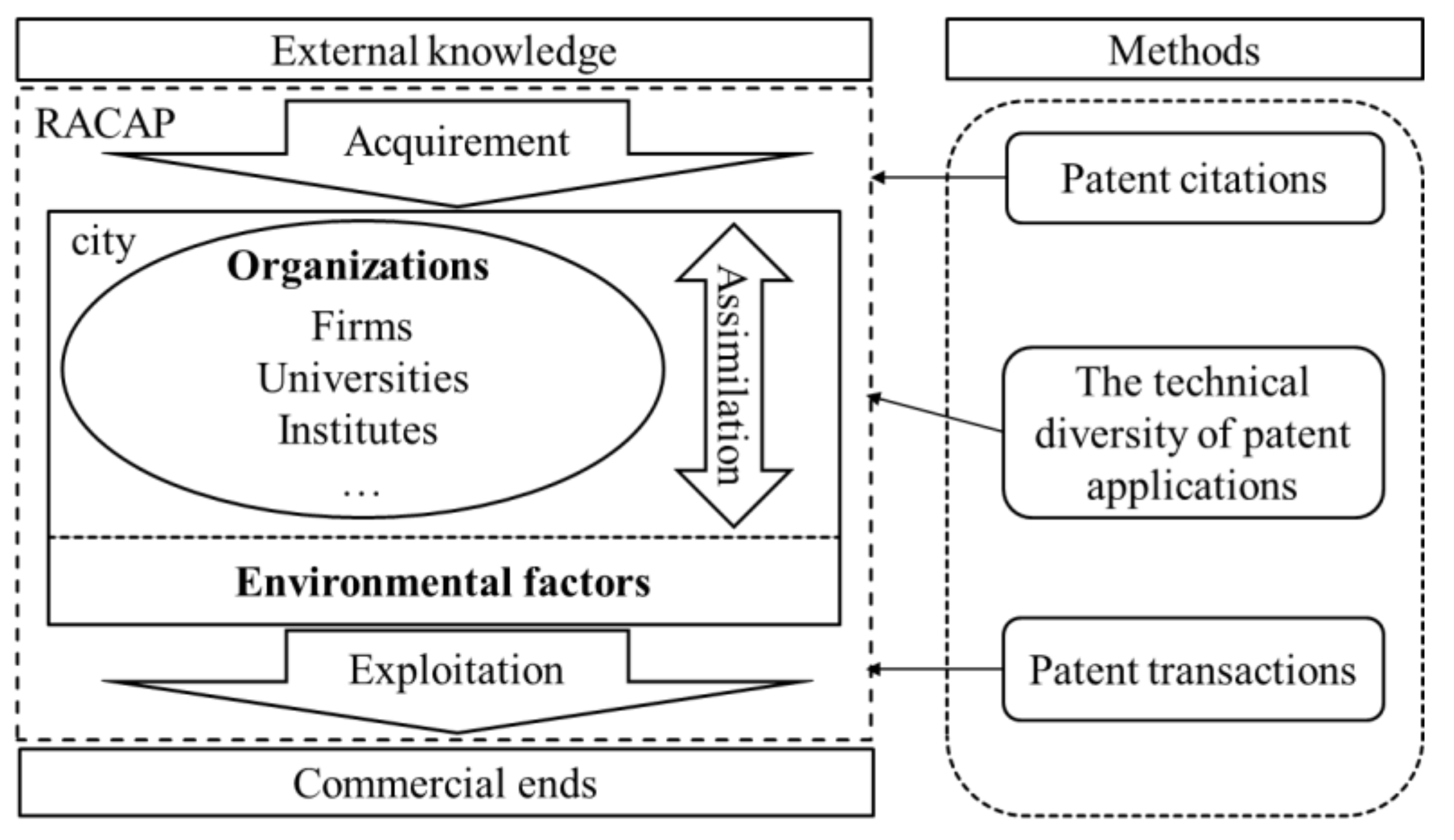
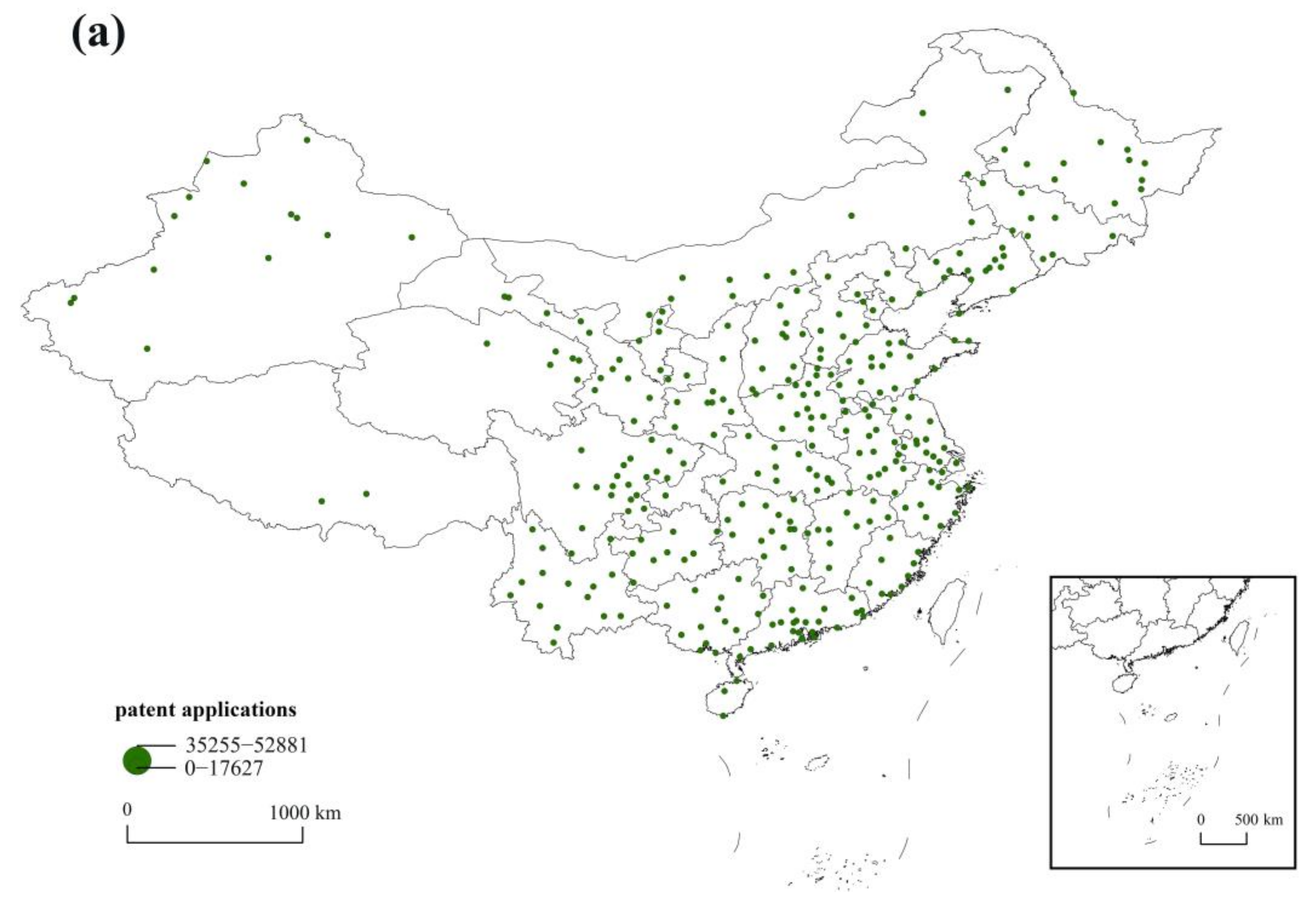
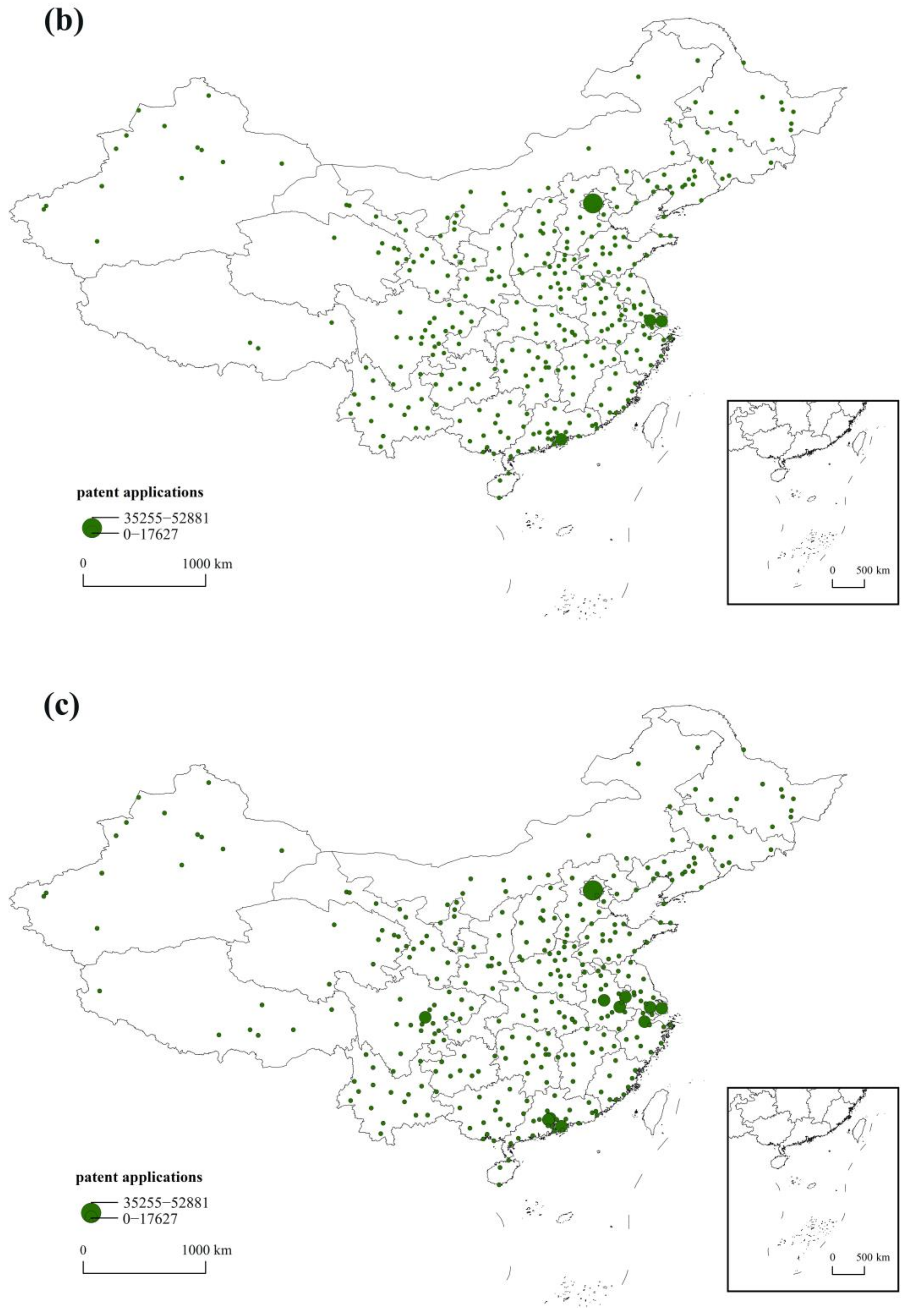

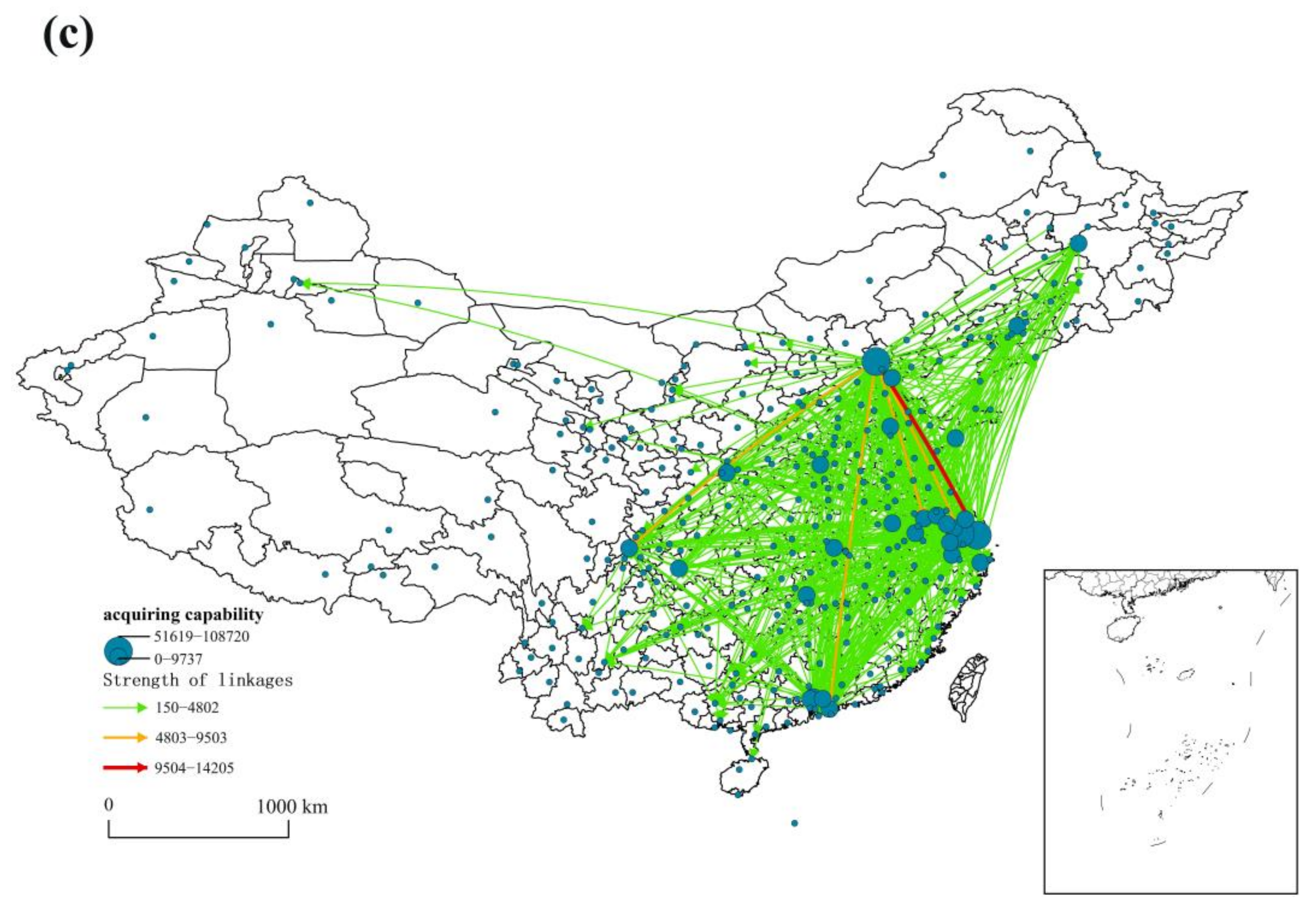
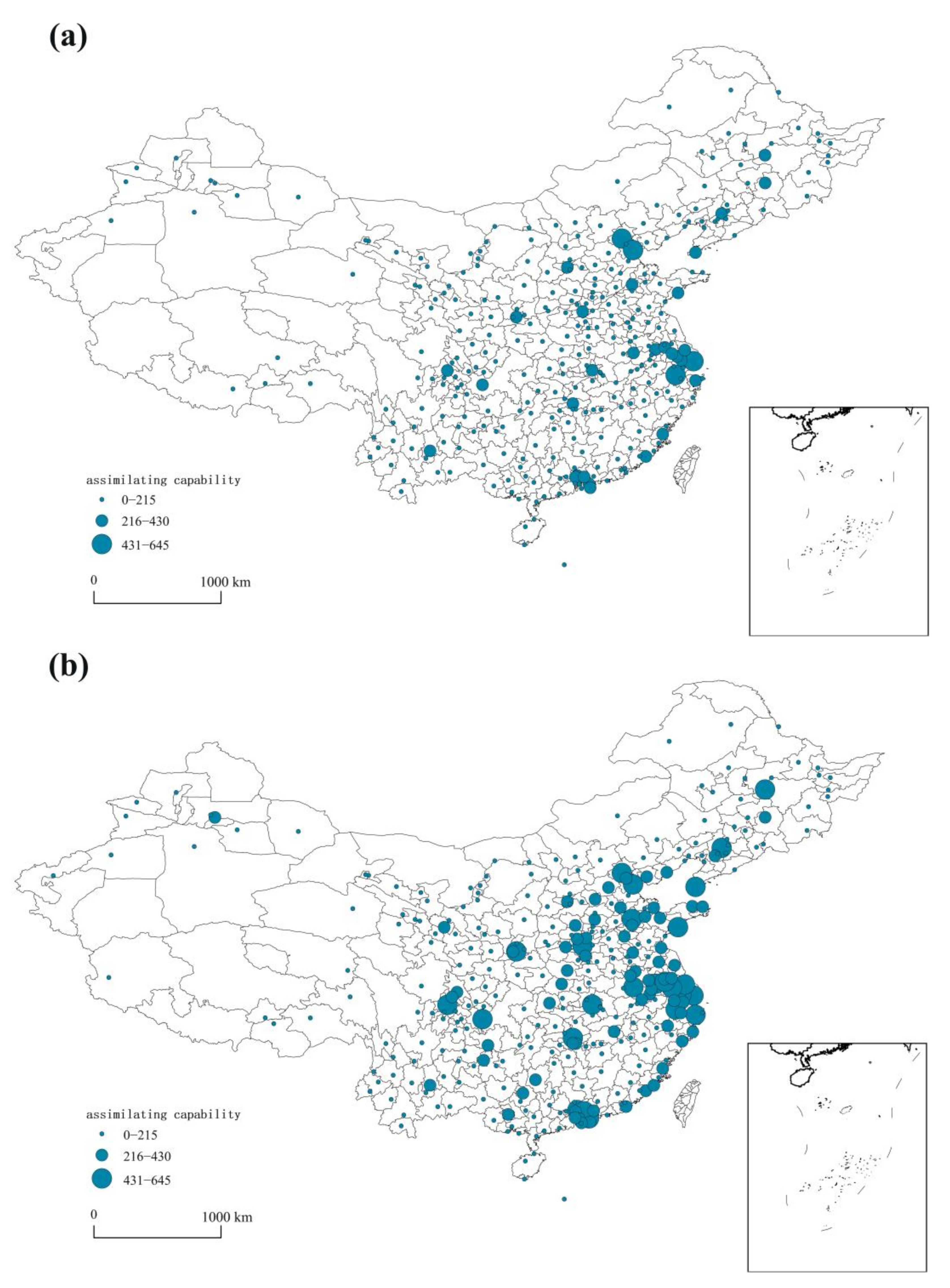
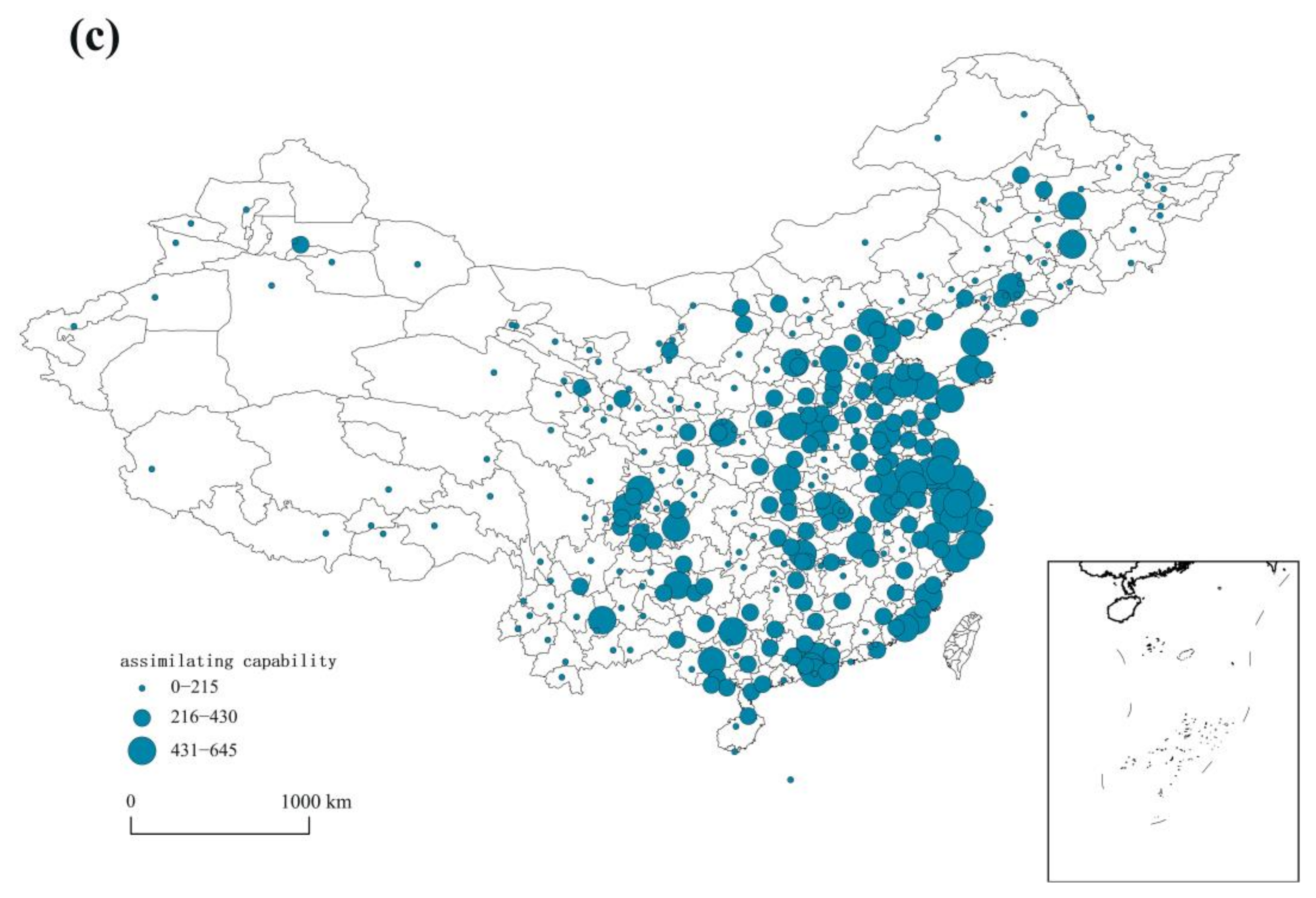


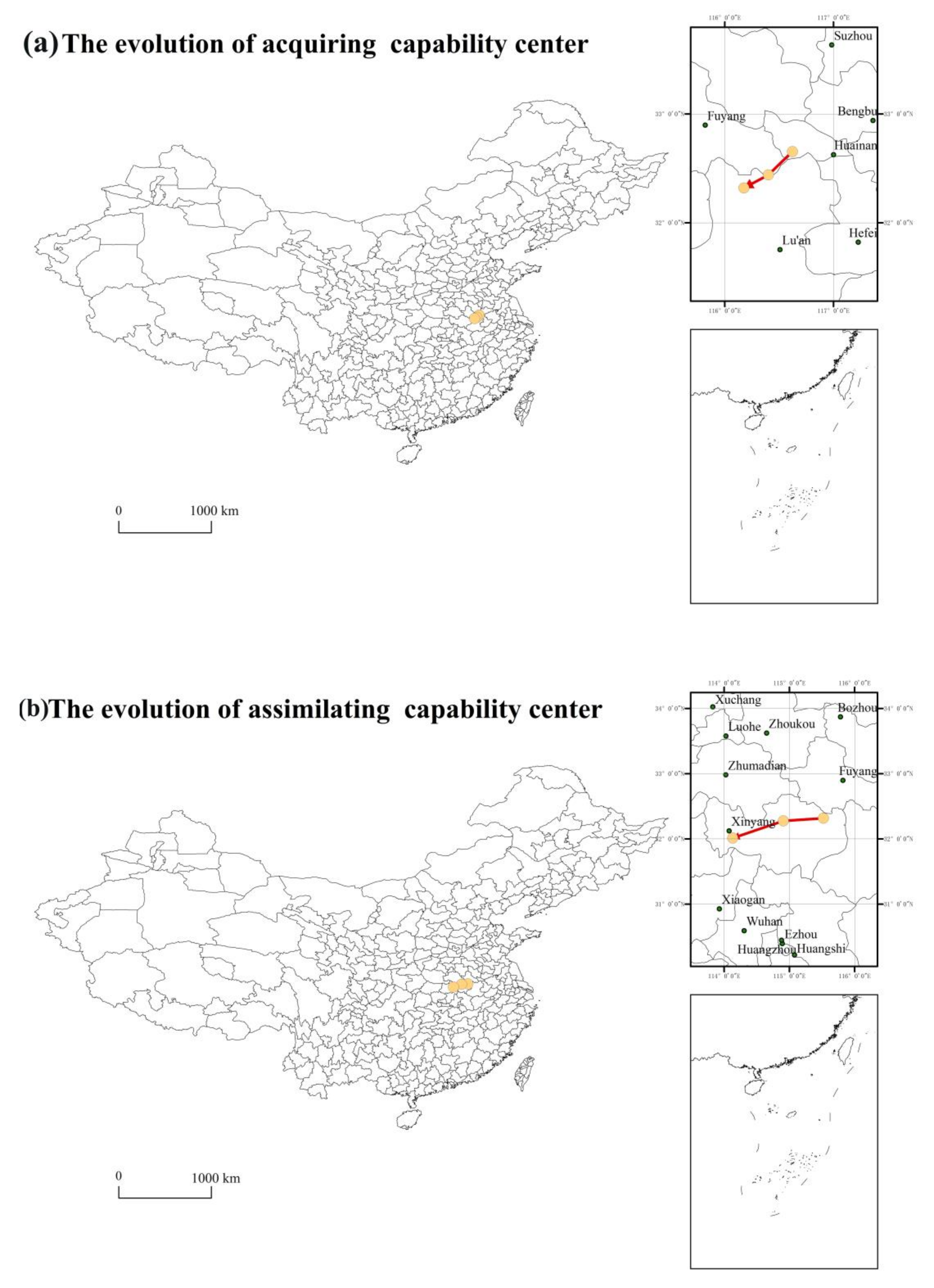
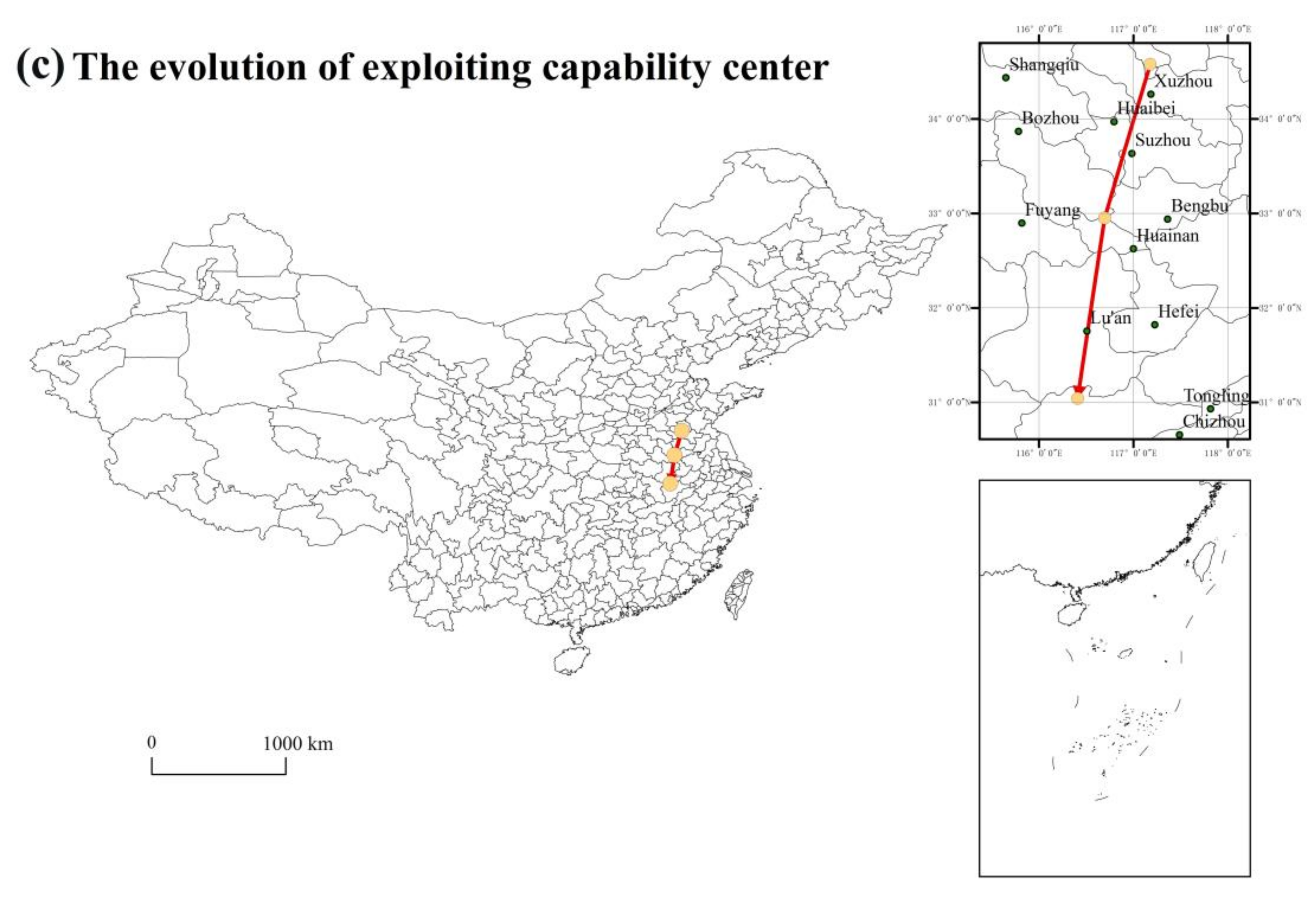
| Variables | Style | Definition | Data Sources |
|---|---|---|---|
| Dependent Variable | The number of patent applications for city i in year t | China City Statistical Yearbook | |
| Independent Variable | The number of patent citations for city i in year t | SIPO | |
| Independent Variable | The diverse technologies for city i in year t | SIPO | |
| Independent Variable | The number of patent transactions for city i in year t | SIPO | |
| Control Variable | People who work in and receive payment from research and development institutions. | China City Statistical Yearbook | |
| Control Variable | All actual expenditures made for R&D in the reference period. | China City Statistical Yearbook |
| Variables | Model 1 | Model 2 | Model 3 | Model 4 |
|---|---|---|---|---|
| 0.300 *** | 0.285 *** | 0.334 *** | ||
| (0.022) | (0.022) | (0.019) | ||
| 3.815 *** | 7.150 *** | |||
| (0.826) | (0.715) | |||
| 13.906 *** | ||||
| (0.392) | ||||
| 0.138 *** | 0.128 *** | 0.131 *** | 0.097 *** | |
| (0.004) | (0.004) | (0.004) | (0.004) | |
| 0.382 *** | 0.328 *** | 0.309 *** | 0.140 *** | |
| (0.015) | (0.015) | (0.016) | (0.014) | |
| W | ||||
| 0.237 *** | 0.261 *** | 0.136 *** | 0.061 * | |
| (0.030) | (0.029) | (0.040) | (0.034) | |
| number of obs | 3654 | 3654 | 3654 | 3654 |
| pseudo R2 | 0.718 | 0.739 | 0.744 | 0.831 |
| log likelihood(-) | 30,220 | 30,130 | 30,120 | 29,580 |
| chi2(1) | 62.47 | 79.76 | 11.66 | 3.17 |
| prob > chi2 | 0.000 | 0.000 | 0.001 | 0.075 |
Publisher’s Note: MDPI stays neutral with regard to jurisdictional claims in published maps and institutional affiliations. |
© 2021 by the authors. Licensee MDPI, Basel, Switzerland. This article is an open access article distributed under the terms and conditions of the Creative Commons Attribution (CC BY) license (https://creativecommons.org/licenses/by/4.0/).
Share and Cite
Jiao, M.; Du, D.; Shi, W.; Hou, C.; Gui, Q. Dynamic Absorptive Capability and Innovation Performance: Evidence from Chinese Cities. Sustainability 2021, 13, 11460. https://doi.org/10.3390/su132011460
Jiao M, Du D, Shi W, Hou C, Gui Q. Dynamic Absorptive Capability and Innovation Performance: Evidence from Chinese Cities. Sustainability. 2021; 13(20):11460. https://doi.org/10.3390/su132011460
Chicago/Turabian StyleJiao, Meiqi, Debin Du, Wentian Shi, Chunguang Hou, and Qinchang Gui. 2021. "Dynamic Absorptive Capability and Innovation Performance: Evidence from Chinese Cities" Sustainability 13, no. 20: 11460. https://doi.org/10.3390/su132011460
APA StyleJiao, M., Du, D., Shi, W., Hou, C., & Gui, Q. (2021). Dynamic Absorptive Capability and Innovation Performance: Evidence from Chinese Cities. Sustainability, 13(20), 11460. https://doi.org/10.3390/su132011460






